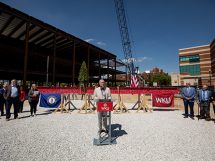Artists use their skills to create unique products
By Lydia Bailey Brown

“When I say ‘creative,’ rarely does manufacturing come to mind. Yet making and manufacturing are the original forms of creation, and manufactured goods are at the core of our economy. Keeping manufacturing local is critical, not just for the direct jobs it creates, but for the induced economic growth (three times that of retail), keeping innovation local, and maintaining resilience and national security.” says Krisztina “Z” Holly, tech entrepreneur and founder of innovation centers at the Massachusetts Institute of Technology and the University of Southern California.
“Manufacturing is sexy,” says Holly. Where else in the world are artistry and the craft of making something to solve problems so appreciated?
In a consumer-driven market, for nearly 30 years, customized manufacturing that meets consumers’ unique needs has become the manufacturing norm – and I believe we see this best in the creation of art pieces for the sake of innovating our physical spaces.
One difference in the manufacturing of art is the pace of the process. In the creation of customized art, it’s “really slow manufacturing,” according to Pennsylvania’s Festival of Making, something to be valued because the pace actually creates the uniqueness and quality of the product. Often, the slower the process, the more valuable product. In creating the one-of-a-kind production, an artist puts to use operations skills and harnesses his or her own Six Sigma Black Belt mindset to avoid waste and provide the best product possible.
Another difference is the location of the blueprint – customized art pieces start from a different place. Potentially a piece will be functional in other ways and provides utilitarian purpose as well, but the location of the blueprint starts somewhere in the manufacturer’s (artist’s) soul.
In the case of wood sculptor Tim Hall, who carves birds in a variety of realistic settings at his garage studio in Ravenna, his blueprint is divinely inspired. Each piece he creates is signed, numbered and bears the inscription “Made by Tim Hall with God’s help.”
Hall, an artist in the Kentucky Arts Council’s Kentucky Crafted program, had a traditional manufacturing-related job – carpentry – until high interest rates hit the housing market in the late 1970s and early ’80s. When his carpentry career waned, Hall parlayed that love of working with his hands and wood into his hobby, carving.
That blueprint, though, is a work in progress, he told the Lexington Herald-Leader in 2015.
“I’m still studying and trying to improve (my work),” he told the newspaper. “I study all the time and take pictures and change my patterns. I’m always trying to make the next one just a little bit better.”
On average, Hall’s work usually takes a little more than one week to create, though he says birds in flight take longer.
“I just completed a quail in flight that took about two months,” he says.
Public muralist Andee Rudloff of Bowling Green said her creative blueprint is inspired when creative people notice things that other people don’t.
“That becomes more and more what you do every day,” Rudloff says, when speaking of connecting people to art. “You can’t not do it.”
Rudloff says she is usually able to complete one of her murals in about a week, but that she has done projects that have taken years to finish. Regardless of the length of time she takes to complete a piece, an important element of her creative blueprint is the connection of people.
“As I became a painter and a muralist, I realized the way to do this was to involve people in conversation,” Rudloff says. “Their words can become images. I’ve tried to bring people to that art conversation through my mural work, I do that in a variety of ways. I’m happy when people can connect to it.”
Art impacts people.
Let’s admit it! Art is the most invigorating of manufacturing processes – it turns our socks, engages us, invites us, makes us drool, and keeps us happy. The artist is the ultimate of operations geeks. Go out and support your local ops geek today and praise her or his process, and you invest in the ultimate economic development of innovative manufacturing in Kentucky.
Lydia Bailey Brown is executive director of the Kentucky Arts Council.




















Add Comment